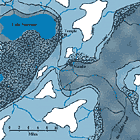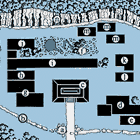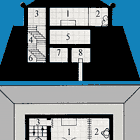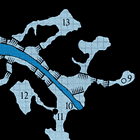Adventure Scenarios & Ideas
![]()
by Phil Holmes (aka Dave Morris)
An adventure for five to eight characters of 4th-6th level or RuneQuest characters of 45%-65% weapon skills, suitable for use as am Advanced Dungeons & Dragons scenario, a non-Gloranthan RuneQuest adventure or for Empire of the Petal Throne.
Note: This scenario was first published in White Dwarf issue 54 (June 1984.) Permission has been given by the author to publish on the web. The original title graphic has been reproduced because it’s such a wonderful example of early 80s typography!
GM’s Introduction
This adventure is based on Professor MAR Barker's fantasy world of Tékumel outlined in Empire of the Petal Throne. For AD&D or Rune Quest-just assume that the adventure is located in some distant part of your campaign world. Where EPT monsters are used I have 'reinterpreted' these for AD&D and RQ use.
The Worship of Lord Ksarul
Ksarul, Ancient Lord of Secrets, Doomed Prince of the Blue Room, Master of Magic and Grammarie, is the god of those who seek knowledge for the sake of power. Long ago, when gods still walked among men, Lord Ksarul gathered his forces and brought these against the other gods in a war for supremacy of the Universe. He was aided by his monstrous servant, the minor deity Gruganu, the Black Sword of Doom. Together these two came close to attain–ing the ultimate victory they sought, but at last the other gods joined together and defeated Lord Ksarul at the fabled Battle of Dormoron Plain. They stripped him of much of his power and then imprisoned him in a place between the planes of existence - a chamber of flickering azure light where Ksarul is sunk in deep stasis-sleep. Even the dreaming mind of Ksarul is still powerful, however, and thus he guides the loyal Gruganu (who escaped his master's fate) in an effort to find the Ten Keys of the Blue Room which will free him to wreak vengeance on all the gods.
The priesthood of Lord Ksarul (who wear smiling masks of silver, black velvet robes and a mortarboard-shaped head-dress) is very highly organized and secretive. But despite their theoretically evil' aims, many of the priests are simply dedicated men of learning, respected scholars and physicians. Most of the Doomed Prince's followers are thus Lawful Neutral in alignment - although there is a small inner clique of zealots, the Ndalu Society, who devote their lives to the search for the Ten Keys and whose methods and alignment are definitely Evil.
The Goddess of the Pale Bone
This should be revealed only to clerics, Lhankor Mhy Initiates or EPT characters with the scholar skill at the appropriate time. The Goddess of the Pale Bone is one of the Pariah Gods, an utterly inimical and Chaotic deity whose worship is almost universally proscribed. Her few followers are the sort of psychotic outcasts who give Chaotic Evil a bad name - human sacrifice is the least appalling of their activities.
Player's Introduction
By chance, one of you discovered some information concerning a temple to Ksarul located in the Do Chaka Protectorate, a region far to the west. The records you have looked at show that the temple was founded in the year 2157. (The year is now 2361). Another brief reference, dated 2270, states that the temple was abandoned during the reign of the Emperor Heshtuatl (sometime between 2168 and 2234) and that the priests' exodus was apparently so hurried that most of the temple relics and treasures had to be left behind. You set out at once.
Your journey west has brought you over a thousand miles - much of this along the Sakbé roads, huge raised causeways twenty feet or more in height and up to fifty feet across. You left the Sakbé road three or four days ago and travelled north along the River of Red Agates towards the mountain range known as the Atkolel Heights. Through a pass you have come to the village of Mandir, nestled at the foot of impressive cliffs. Somewhere beyond - only a few miles away now - lies your goal
GM’s Notes
The Village of Mandir
The sun is low over the western hills as the party approach Mandir. In the north, storm clouds gather. The village consists of about thirty houses - low wooden buildings with many-sided totemic pillars at each corner supporting roofs of black tile.
The party are greeted formally by Tulkesh hi-Nraga (surnames carry the 'hi-' prefix.) Tulkesh, a slightly-built man about forty years old, is village headman and senior member of the Clan of the Advancing Shaddow, a foresters clan which traditionally reveres Lord Ksarul, to which more than three-quarters of the villagers belong. He is quite affable towards strangers - particularly if the party includes Ksarul worshippers - and will invite them to dine with him and stay for a few days. No payment is expected unless the party presume too much on the villagers' hospitality.
Also at dinner is a strange young man called Nomikaru hi-Teteli, the local priest of Lord Ksarul. As soon as the meal has begun he starts to chew hnequ weed (a narcotic) and becomes by turns either vague or abstractly argumentative. He is in fact a disgraced member of the Ndalu Society, who chafes at his demotion to lowly village priest.
Tulkesh will freely answer any questions. Mandir was settled by pioneers from the east two hundred years ago. The temple that the players are interested in was founded at about the same time, but it appears to have become deserted only a half-century later. Tulkesh is not sure of the details - just that the priests abandoned the place after a number of unexplained events. One story he has heard is that the priests were later attacked and killed by outlaws as they made their way back to the Sakbé road, so a full report was never made. From time to time since then there have been mysterious disappearances, and nowadays people try to give the temple a wide berth. Nomikaru adds that there are probably Hra and Vorodla (see below) guarding the temple compound, and will relish describing these creatures to the ignorant. The party may choose to look around the village before heading for the temple. If so, they will certainly encounter Major Chengath hi-Lantau, a retired army officer who carves and lacquers decorative wooden screens. He will carve a screen to order for 200 kaitars / l00gps / 200 lunars.
Getting There
The trail from Mandir into the hills is steep and overgrown, and now quite arduous after a recent storm. There is a steady, grey drizzle and the skies threaten further storms, for this is Shapru, the month of rains.
The whole trek takes about seven hours for a moderately-burdened party. This assumes ten minutes rest each hour. The last part of the journey involves trudging up a particularly steep and muddy path, and characters who don't take a ten minute break at the top will fight at -1 for the next hour owing to fatigue.
Temple Background for the GM only
Although founded ostensibly as a centre of worship for the people of Mandir, its major value to the priesthood of Lord Ksarul must have been as a spiritual retreat; an isolated monastery where priests could conduct their studies and research without disturbance from the factional disputes common within city temples. A number of Hra and Vorodla were provided by the funders of the temple, the Society of Blue Light, a faction devoted to pure scholasticism and opposed to the Ndalu Society.
Unbeknownst to the temple founders, the caverns below the shrine were used millenia ago by devotees of the Goddess of the Pale Bone. In fact this was the root cause of the troubles at the temple, as will become clear...
The Temple
As the party approach, the temple's ruined state becomes clear. Some time in the past the gatehouse was shattered by lightning, charred, and then rotted by the elements. The stone wall around the temple compound has collapsed at several points. The paving stones within are cracked and subsided, the buildings are tangled with vines and in disrepair.
Dominating the temple is the twenty-foot pyramid on which stands the shrine dedicated to Lord Ksarul. Just as the party pass through the ruined gate, dark, winged shapes rise up from here and the colonnade below, soaring aloft and then swooping down on the party...
These are Vorodla, guardians of the temple. There are seven of them:
Vorodla
RQ: 5-point armour; HP10, 11, 12, 13, 13, 14, 15; Move: 6/12; POW: 13;
Sword (1d8+1+1d4 and exposure to Soul Waste), SR7, 45%.
AD&D: AC5; HD4; HP12, 18, 21, 10, 15, 22, 23; Move: 6"/24"
1 attack for 1-8 +20% chance of energy drain.
EPT: AC5; HD4; HP1O, 14, 16, 9, 12, 18, 19; 20% chance of level drain.
Notes: Vorodla are winged undead; dead warriors restructured and reanimated by the arcane sorcery of the priests of Lord Ksarul. They fight fanatically until cut apart, and must then be burnt or they will regenerate and rise up within two turns. By night, or in pitch darkness, Vorodla fight at +2 (RQ: +10%). There is a 20% chance that a hit by one of these creatures will lower the victim by one experience level (RQ: exposure to Soul Waste). AD&D: Vorodla are turned as wights by priests of Ksarul and as ghasts by other clerics. (On a 'D' result, a priest of Ksarul has a 35% chance of bringing the creature into permanent, if grudging, service.) They are Neutral (evil).
Because it is heavily overcast they attack at + 1 (RQ: +5%) even during the day, unless one of the characters uses weather control or the like to dispel the clouds.
The Library
The roof has fallen in at the western end - many of the books are rotten and worm-eaten, but three sealed Chlen-hide (bronze) chests have preserved the most important books in excellent condi–tion. There is also a scroll of necromancy and the grey hand (AD&D: hold monster and disintegrate; RQ: scroll giving 10% increase in Knowledge skills) written in the Tongue of the Priests of Ksarul. The real find, though, is the temporal codex of the temple - the daily record of events. The entries of interest deal with the months Hasanpor and Shapru of the year 2215:
13th HASANPOR, 2215
In the midst of preparations for the coming ceremony, two priests who had climbed down to the forest to col–lect sauqun flowers for the festivities went missing. One crawled back into the temple compound in the early hours of this morning, bloodied and tattered. His tongue had been ripped from his head. Ministrations proved ineffective and he died without providing an account of what had befallen.
15th HASANPOR, 2215
The Eventuation of Holy Pavar was commemorated. The celebration was more muted than in previous years owing to the absence of four of the six slaves prepared for streblosis. These four must have escaped just a few hours before dawn, but their means of egress from the temple precincts is by no means apparent. None of the other slaves seems to have witnessed the escape - a story which they main–tain even under diligent torture. It remains a mystery.
27th HASANPOR, 2215
Archdeacon Ishankoi hi-Reshlan has disappeared - spirited away, so to speak, in the middle of the night. Magical means have been employed in an effort to contact him, to no avail. His Holiness the Archiman–drite has sent word via Mandir to the Palace of the Realm in Khirgar. Ishankoi has always seemed a stable fellow, and it is difficult to believe him capable of such dereliction of duty as to go missing only hours before the Returning of the Mantle of Blue.
29th HASANPOR, 2215
Those of us who thought ill of Ishankoi have had cause to revise our judgement since his mutilated form was found in the Lower Shrine shortly after lunch. Who can have performed this horrible deed? Recalling the fate of Shrakan and Elvaru earlier this month, one is forced to the conclusion that some monstrous being has come up from the forests. In spite of the heavy rainfall, Yugao hi-Ludum insisted on taking another message to the runner in Mandir.
3rd SHAPRU, 2215
The heavy storms of the last few days continue unabated. Tekketal hi–Kuroda has gone missing. One can only hope he has not suffered the fate of Ishankoi. Yugao hi-Ludum sug–gested at dinner that these strange events result from an incursion of Shunned Ones from the forest, and is himself preparing a note to this effect to send to the Omnipotent Azure Legion in Khirgar - though some of us believe it would be more seemly to first inform the Temple at Mrelu.
6th SHAPRU, 2215
Tekketal's corpse has been located in the Hra pit, mutilated if anything eve,i more gruesomely than Ishankoi. To some extent this was due to several of the Hra having mistaken his body for an exotic item of their diet.
Further, two acolytes have gone missing.
8th SHAPRU, 2215
Goduku hi-Raitlan has now van–ished, along with his personal ser–vant. On the orders of His Holiness, Yugao hi-Ludum used mediumship to communicate our troubles to the Temple at Mrelu. We are assured that investigators have been despatched.
9th SHAPRU, 2215
Like one who is infected with the eggs of the nkek-worm, we have suffered from a traitor within! Yugao hi–Ludum has been uncovered as the source of our woe! Along with two young acolytes he has been worship–ping at an ancient shrine to the terrible Goddess of the Pale Bone in the caverns below our temple. After a few minutes of careful questioning he lapsed into a ghastly calm which he retained even when flayed alive. After this his heart was cut out and the corpse flung into the catacombs where he had his shrine. The acolytes were similarly treated, but spoke freely of a baleful influence which called them to the caverns. They died more insane than a Hliir. Our troubles are at least now at an end.
10th SHAPRU, 2215
After the Visitation of the Dormant Lord, His Holiness the Archiman–drite was found to be missing. A thorough search of the catacombs uncovered his butchered form, treated not unlike that of Yugao. No magic could resurrect him. Moreover, there was no sign of the carrion deposited in the catacombs only yesterday.
11th SHAPRU, 2215
Two more were found dead, and those who remained have been forced to evacuate the temple. Apart from a few slaves only! remain, for l am too infirm to travel far. land the slaves keep to the library now. I have released the Hra and even the Vor–odla in the temple precincts, with instructions to attack even those robed as priests of our Supreme Lord. The Vorodla accommodate themselves to such orders with relish, of course, but the Hra seemed dully reluctant. It is tempting to think of this as a sort of loyalty, but I know that the spark of true reason has jaded from their dead minds and it is only the illusion of thought that I perceive in them.
The rain is a heavy curtain in the courtyard. Once or twice I thought I glimpsed a figure out there.
12th SHAPRU, 2215
There is food for only two more days, but I do not think it will come to that. I have had an idea for a treatise on the ethology of the Hra. A pity I will never get the chance to write it.
The Shrine
The roof of the shrine is of a sturdy, black-lacquered wood which has suffered little from time and the elements. There are steps up the south side of the pyramid. The doors are locked.
1. The Outer Shrine. There is an altar stone of blue marble against the north wall, under a silver crescent moon and azure beetle - one of the insignia of Lord Ksarul.
2. Side-chapel. Behind a locked bronze grille is a small shrine to Ey'un, Knower of Skills, the aspect of Lord Ksarul to whom this temple was particularly dedicated. There is a small steel (AD&D: platinum; RQ: iron) statue of the skeletal Ey'un. This is worth up to 150,000 kaitars / 75,000gps / 150,000 lunars, although it would be considered an act of terrible sacrilege if anyone less than a Cardinal of the priesthood of Lord Ksarul were to remove it from the shrine. AD&D players should not be given its full XP value, if it is taken. (It should be worth about 3,000XP).
3. Steps lead down within the pyramid.
4. A landing. The steps continue down and there is an archway to the east, from the chamber beyond which issue forth four Hra:
Hra
RQ: 6-point armour; HP20, 21, 22, 23; Move: 8; POW: 14;
Sword (1d10+1+2d6), SR7, 75%; will regenerate unless slain by magic; can detect life at no POW cost.
AD&D: AC4; HD7; HP31,28,28,24; Move: 12"; 1 Attack for 4-11;
EPT: AC4; HD7; HP24, 22, 22, 20.
Notes: These huge (7') undead warriors are sometimes used by the priests of Ksarul as temple guards - but only in the lower catacombs, as they cannot stand the light of day. They are turned as spectres except by priests of Ksarul, who turn them as wights and gain permanent control of the Hra on a 'D' result. Even if completely hacked apart in melee, a Hra will reanimate after two turns and pursue its opponents; it has the tracking abilities of a ranger (RQ: detect life). In appearance Hra are gaunt and grey, seeming much like a wight. After killing their foes they drain them of all blood and bodily fluids, leaving only a shrivelled husk. If dispelled by a cleric or slain by a paladin with a Holy Sword, the Hra is completely and permanently destroyed.
5. The Lower Shrine. A chamber of black stone, intended for the more sacred and secret rituals. There is a crescent moon symbol inlaid in polished quartz shards into the floor.
6. The stairs end. A locked bronze grille bars the way.
7. Antechamber to the Inner Shrine. Each of the double doors to the east bears the Bound Claw emblem on panels of beaten silver.
8. The Inner Shrine. An effigy of Lord Ksarul, carved of black wood and masked with silver, lies on a couch studded with blue mosaic. He holds a silver staff topped with a large sapphire cut to resemble a beetle. The whole room is faced with blue marble.
The mask is worth about 200 kaitars / 100gps / 200 lunars; the staff, 150,000 kaitars / 75,000gps / 150,000 lunars. The same applies as with the statuette of Ey'un in the side-chapel above.
A search of this room will reveal lines of faint scratches on the floor running between the couch and the east wall. If the couch is lifted up slightly it can be slid aside to reveal a pit. This requires a combined strength of 150 (AD&D/RQ: 28).
The Caverns below the Pyramid
These caverns were a centre of worship for the sect of the Goddess of the Pale Bone centuries before the eastern pioneers colonized the area and built their temple to Lord Ksarul.
The only worshipper here now is Yugao hi-Ludum,the treacherous priest of Ksarul mentioned in the extracts from the temporal codex.
Yugao hi-Ludum
AD&D:
9th level cleric; Str: 16; Int: 11; Wis: 10; Con: 15; Dex: 11; Cha: 13; AC6; HP50.
Equipment: Shield +3*, Lucern hammer +1*, Wand of Fear (2ch)
Spells: 1st - Curse, command, cause light wounds, sanctuary.
2nd - Hold person, know alignment, spiritual hammer (x2).
3rd - Cause blindness, cause disease, dispel magic.
4th - Cause serious wounds, poison.
5th - Commune.
EPT:
9th level priest; Str: 89; Int: 55; Con: 81; Pow: 60; Dex: 52; Com: 1; AC5; HP38; (+2 hit, +2 damage).
Equipment: Shield +3*, Warhammer +1*, Excellent Ruby Eye (6ch), Eye of Allseeing Wonder (31ch).
Spells: Basic MU skills to Nature Control.
I - Fear, plague, shadows.
II - Cold, creatures, the hands of Kra the mighty.
Ill - Doomkill, the silver halo of soul stealing.
(*These items are only magical when used by Yugao.)
RQ
STR: 16; CON: 15; SIZ: 11; INT: 11; POW: 18; DEX: 11; CHA: 13; HP16; Defence:5%.
Equipment:Medium shield, warhammer (iron); special powered crystal which gives protection 3 at all times.
Spells:Befuddle, demoralize, disruption, bludgeon 3, darkwall, invisibility, (repair, detect life, silence, extinguish, mindspeech 3, dispel magic 2).
Rune Magic: Shattering, blinding, shield 3, summon small shade.
Skills:Combat skills 55%; stealth 55%; perception 80%.
Allied Spirit in bone talisman: TNT: 11; POW 15.
Yugao's life-force has been sustained all these years by the power of the Goddess. He presents a grisly spectacle, still in the state that his erstwhile comrades left him - flayed to the waist, his skin hangs like a kilt leaving an upper torso of raw flesh and sinew, a skull-like mask of a face with lidless, staring eyes. There is a gaping hole where the priests tore his heart out. Most of his abilities now derive from his deity and so he should be treated as a priest (AD&D: cleric) as indicated above. Outside the caverns Yugao's life would ebb away, at the rate of one hit point a turn.
Besides Yugao the caverns hold another danger - the Jalush, a creature which has guarded the Goddess' fane for hundreds of years. The Jalush may be a unique, demonic creature or it may be the last survivor of an extinct species. It has six limbs, walking on the back four and using the forelimbs for grasping and striking. It has an outer integument, smooth and ivory-pale, with sharp clusters of spines at its joints. It stalks with the slow, precise movements of a praying mantis and strikes with a scorpion's vicious speed; any NPC of 4th level (RQ: lay member) or less has a 15% chance of fleeing in terror if suddenly confronted by it.
Jalush
RQ:
HP28; Move: 8; POW: 20; Talons (1d8+3d6), 5R4, 95%
| Righthindleg | (01) | 10/9 |
| Right foreleg | (02-04) | 10/9 |
| Left hind leg | (05) | 10/9 |
| Left foreleg | (06-08) | 10/9 |
| Abdomen | (09-10) | 10/10 |
| Chest | (11-12) | 10/10 |
| Right arm | (13-15) | 10/9 |
| Leftarm | (16-18) | 10/9 |
| Head | (19-20) | 10/10 |
AD&D:
AC0; HP54 (from 11 dice); Move: 12"; 1 attack for 4-24; Neutral Evil.
EPT:
AC1; HP44 (from 11 dice); Move: 12"; Other notes: see below.
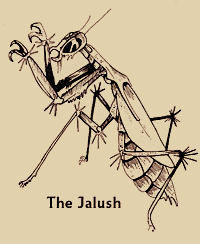
Any character hitting the Jalush has a chance of being scratched by its poisonous spines - 15% if the character is AC5 or less, increasing by 1% per AC point above 5. If the character fails his saving throw he loses 5 points of constitution (AD&D: 1 point) at once and a further 5 points (AD&D: 1 point) every two minutes. This continues until the character is dead or the poison neutralized. This can only be accomplished with the Ineluctable Eye of Healing (AD&D: Keoghtom's Ointment or full wish), and even this will not reverse the damage! The poison also causes 1-3 hit points permanent damage whether or not the character makes his saving throw! Nothing short of Divine Intervention will heal its effects. (RQ: the character must make his luck roll to avoid the spines. The poison is potency 15, and if it overcomes the character's CON, he should be considered to have contracted the terminal form of Creeping Chill disease. If the poison does not overcome the character's CON, he merely loses 1 point permanently in the scratched location.)
The Jalush has a saving throw of 6 against all spells, technological devices, etc. It has keen senses and moves almost silently despite its size: it surprises the party on a roll of 1-4 on d6 and is itself surprised only on a roll of 1 on d10.
For any encounter in the caverns, roll d6:
1-3 the Jalush
4-5 Yugao
6 Yugao and the Jalush
Of course, Yugao is always somewhere in the caverns. Have the party encounter him in the Goddess' fane if they haven't run into him before then.
9. Low chamber. There is a drop of about twenty feet from the floor of the Inner Shrine down a narrow shaft which opens into the roof of this cave. The climb down is pot difficult. A tunnel slopes gently downwards from the south-west part of the chamber. The sound of running water can be heard.
10. Underground stream. This dries up in summer, but at the moment is in full flood. The stream is 4' at its deepest point.
11. Secret 'door'. A boulder conceals the narrow passage. It takes a combined strength of 85 (AD&D/RQ: 16) to roll it back.
12. The Goddess' Fane. This cave is taller than most of those here and seems to have been enlarged by excavation at some time in the past. The walls have been stained white and covered with squarish crimson designs. There is a rough altar - a natural table of rock - to the south-east. On this is a rough, pitted idol of light grey stone, depicting a globular being with six thick, curving legs and the face of a thin-lipped woman.
Anyone touching the idol will receive a fleeting but horrible vision: a tall, unsmiling woman dissolves into the repulsive apparition of a torn, rotting monstrosity - the woman's head, shoulder and right arm - flying through illimitable darkness towards the viewer. She wields a great warhammer and seems to be shrieking in rage with her hair streaming as if in a wind. However, there is no sound.
After a moment this vision fades; the idol will not affect a character more than once. Removed from the fane, it loses this power.
13. Skulls and broken bones - the Jalush's victims over the years. There is a 4' wide shaft in the floor of this chamber, set with many razor-sharp chips.
If a character manages to get down the shaft he will feel a sense of tremendous premonition, as though on the verge of a great discovery. Rather than merely telling the player this, the GM should try to create a mood, to heighten the sense of significance - describe the dank air at the bottom of the pit, the rasping of the character's own breath in the stillness, the rough wood of the torch in his hands, its heat on his face... There at the bottom of the shaft lies a 6" sphere with a stylized eye-symbol inscribed into it, seeming to watch the character. When he picks it up it feels almost icy cold, and remains so even if heated. Though it seems to be made of grey marble, it cannot be cracked or damaged in any way.
This is one of the Ten Keys required to free Lord Ksarul, presumably concealed here by one of the followers of the Goddess of the Pale Bone. It cannot be detected as such by magical means, and only a great scholar could identify it for certain. Nonetheless, anyone who sees it will have some kind of 'sixth sense' as to its importance.
14. Cave entrance and waterfall. The stream emerges from the cliff face. The forest is a hundred feet below. From here characters can see Lake Ngusinaa stretching to the west and, mistily through the continuing drizzle, the great mountain peaks in the north. There are a number of ledges and handholds which make the cliff an easy climb.
After the adventure
For those who like to loot, there's about 900 kaitars/450gps/900 lunars in cash distributed around the temple - mostly in the bursary strongbox in the administration building, but some also in the private quarters.
If the players take the temple relics (the statuette of Ey'un, etc) then they had better be careful about where they sell them if they don't want the priests of Ksarul as enemies. Even if they return the relics to the priests, the latter may still view the removal of these items from the temple as questionable or even sacrilegious. The optimum course would be to leave the relics in place and bring back a Cardinal from the priesthood to recover them. The priests of Ksarul will give about 25% of the relics' value as a reward to their discoverer.
If the party show the Key to Nomikaru hi-Teteli, back in Mandir, he may try to get it from them so that he can take it himself to the priesthood. This is not to say that Nomikaru will recognize it as being one of the Ten Keys, merely that it is an interesting artefact which could help him to ingratiate himself with his superiors.

